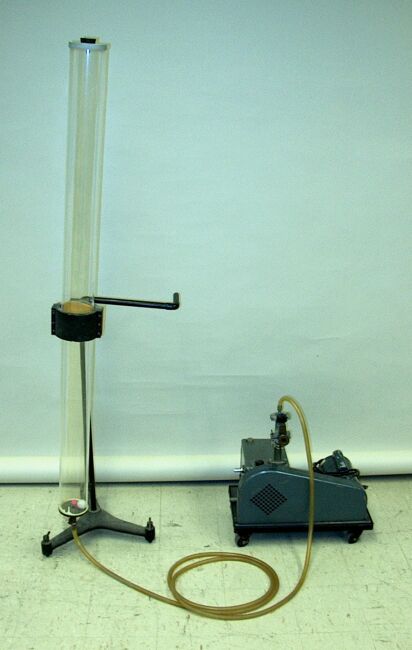
Inside the plastic cylinder are a ball and a feather. The cylinder is mounted on a pivot at its center, and you can rotate it by means of the crank. If you rotate the cylinder quickly to exchange the two ends, then stop when it is vertical, you and the class can watch the ball and feather fall to the bottom end of the cylinder. With the cylinder filled with air, the ball falls quickly to the bottom, while the feather floats down after it. You can evacuate the cylinder by means of the vacuum pump. (Make sure that the valve at the end of the cylinder is open.) When the cylinder is evacuated, the ball and feather fall together. (If the feather gets stuck at the evacuation port, closing the valve will stop the air flow and release the feather.)
This demonstration is an alternative to demonstration 08.09 -- Cube vs. feather, in which you suspend a cube and feathers inside a large plexiglas tube by means of an electromagnet, and then release them by cutting the current to the magnet. As noted on the page for that demonstration, questions regarding the motion of falling objects date at least to the ancient Greeks. As quoted in Physics, Part 1, Third Edition, by Robert Resnick and David Halliday, Aristotle held that “the downward movement . . . of any body endowed with weight is quicker in proportion to its size.” Much later, Galileo Galilei performed experiments, both with objects falling vertically and with balls rolling down an inclined plane. From these, he was able to determine that the way balls accelerated as they rolled down an incline was similar to the way they accelerated when dropped vertically. Since the acceleration down the incline is a component of the (vertical) acceleration of gravity, g, its magnitude is smaller than g, so the motion of the balls as they roll down the incline is slower than that when they fall vertically. Rolling the balls down an incline thus made it easier for Galileo to time their motion. From these experiments, Galileo found that the acceleration was constant, and that it was independent of the mass of the balls.
It might perhaps still be tempting to think that heavier objects fall faster than lighter ones, especially while watching such things as leaves, feathers and even beach balls float to the ground. All objects that are released from some height and fall back to earth are subject to drag from the earth’s atmosphere. For most objects, this drag is small enough relative to the downward force of gravity, that we do not notice its effect. For objects such as leaves and feathers, however, this drag is significant compared to the force of gravity, so that when they are released from some height, we can see that they fall with an acceleration that is less than g. This demonstration shows that absent the drag due to the atmosphere, a ball and a feather fall at exactly the same rate.
To operate the apparatus, rotate the crank quickly to exchange the two ends of the cylinder, then stop when the cylinder is vertical. As noted above, with the cylinder full of air, the ball falls quickly to the bottom end, while the feather floats down after it. As you rotate the cylinder, then, the motion of the feather lags that of the ball. To evacuate the cylinder, turn on the mechanical pump. (Make sure that the valve at the end of the cylinder is open.) It may be advantageous to have the valve end of the cylinder up when you do this, because with that end down, there is a chance that the feather could become stuck over the connecting port. If this happens, close the valve and tilt the cylinder. The feather should fall away from the port. You can then open the valve and continue pumping if it is necessary. Once the apparatus is evacuated, when you rotate the cylinder as before, the ball and feather now move together. To do this, if you wish, you can close the valve on the cylinder and then turn the pump off. Do not leave the pump off and under vacuum. Please vent the line by opening the valve mounted on the inlet of the pump.
References:
1) Resnick, Robert and Halliday, David. Physics, Part One, Third Edition (New York: John Wiley and Sons, 1977), pp. 43-44.